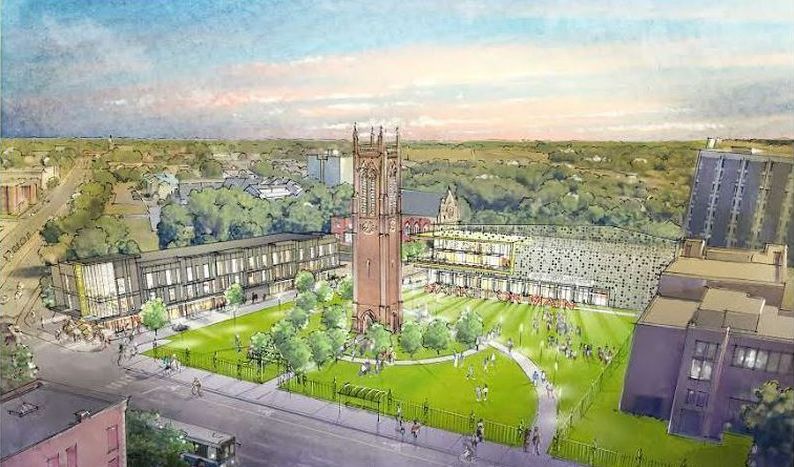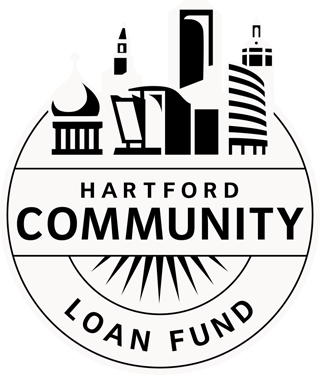Healthy Foods Financing
The Healthy Hartford Hub
Creating Access to Healthy, Affordable Food and Better Health Outcomes for Hartford residents.
Background
Invest Health – Hartford: In March, 2016, Hartford was one of 50 U.S. cities selected to participate in Invest Health, a collaborative initiative of the Robert Wood Johnson Foundation and Reinvestment Fund designed to develop new strategies to improve health outcomes in communities facing the greatest barriers to health. Invest Health - Hartford team members included the University of Connecticut, Hartford Food System, Trinity Health/St. Francis Hospital, the City of Hartford’s Dept. of Health and Human Services, northend-based nonprofit Community Solutions, and city residents.
Research confirmed that residents of the North Hartford Promise Zone (NHPZ) face the most significant barriers to health in the greater Hartford region, including a significantly higher rate of food insecurity. Only one full service supermarket is located within the city limits (a Stop & Shop on the western border) and, for cities its size (100,000 – 250,000) Hartford recently ranked as 8th worst in the US for providing access to healthy and affordable food for its residents. The Invest Health - Hartford team led a comprehensive effort to engage NHPZ residents and other stakeholders in a thorough assessment of the community’s food system, leading to the identification of investable opportunities for improvement. At the conclusion of the 18-month process, the top priority identified by NHPZ residents and other stakeholders was for the development of a new full-service supermarket providing affordable, high quality fruits, vegetables, meat, and dairy products.
Hartford Food Retail - Market Study: Meanwhile, during the summer of 2017, Hartford Community Loan Fund and the City of Hartford’s Dept. of Development Services partnered to commission a comprehensive market analysis to determine both the feasibility and optimal location of a potential full-service supermarket. To find out if and where a store could be sustainable, the study (updated in 2019) assessed three potential sites selected by the City. These sites were: 1) 2895 North Main Street (Terry Square); 2) the Main/Albany intersection; and 3) the Park/Main intersection. Of these, Main/Albany was projected to be the best location for a successful, sustainable full-service supermarket, with Park/Main potentially able to sustain a Discount format store. Of five ‘optimal’ formats applied to the Terry Square site, none was projected to be successful or sustainable. The market study was conducted by one of the grocery industry’s top assessment consultants, MTN Retail Advisors. A summary of the market study’s revenue projections for each of the three sites can be found here.
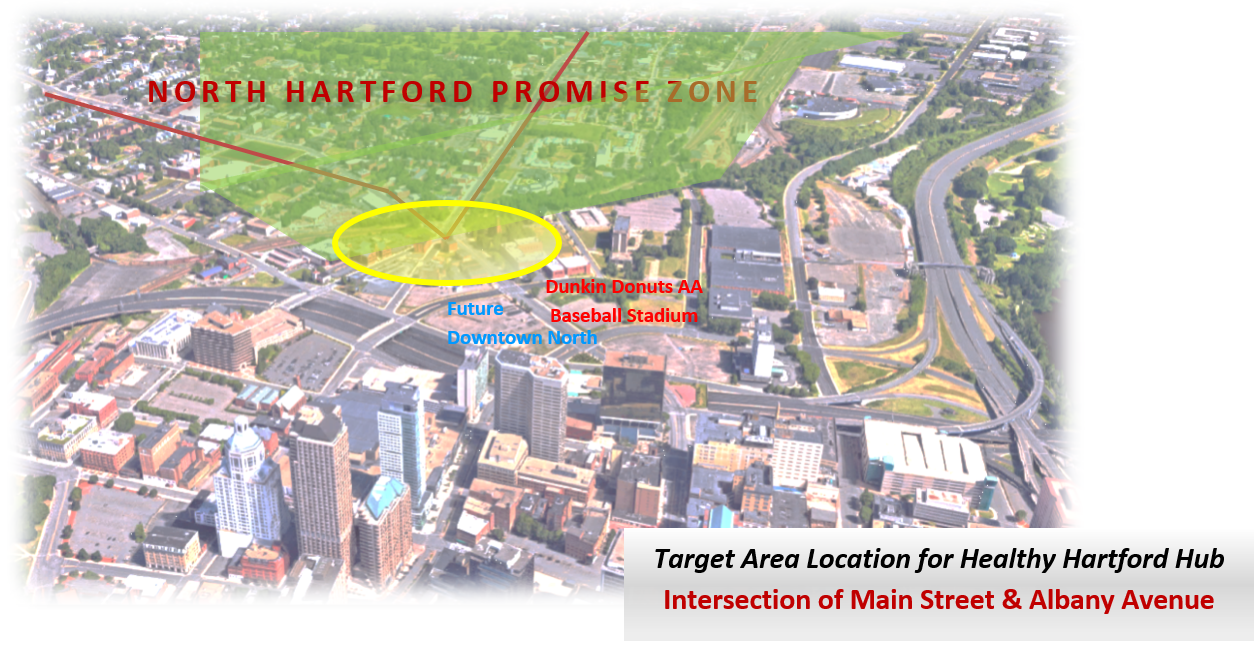
The study also indicated that the NHPZ residents represented the greatest market opportunity to be served, with an additional opportunity to serve the city’s rapidly growing downtown population. The Main/Albany intersection represents the focal point for the greatest number of CT Transit bus lines (nine) which serve NHPZ residents. With ‘Zero Vehicle’ households representing approximately 42% of all NHPZ households, location of the supermarket in close proximity to public transportation is considered a critical factor in a prospective store’s success.
Based on 2018 CT Transit bus routes, most of the 24,000 NHPZ residents will be able to access a store sited at the Main/Albany intersection in less than ten minutes from any bus stop location within the NHPZ. Currently, some NHPZ residents taking CT Transit buses to the Bloomfield Stop & Shop can spend more than an hour in transit each way (the Bloomfield Stop & Shop is the supermarket in the metro area most frequented by NHPZ residents, according to a 2018 Invest Health - Hartford survey). The Main/Albany location is geographically situated at the heart of the city and can be accessed by vehicle in ten minutes or less from each of Hartford’s 14 residential neighborhoods.
Creation of The Healthy Hartford Hub
Based on the strength of the 2017 retail food market study and the results of the Invest Health–Hartford (IH-H) work in the NHPZ, the concept for the Healthy Hartford Hub (HHH) was developed by the IH-H team in collaboration with Hartford Community Loan Fund and the Office of the Mayor of Hartford, Luke Bronin. The HHH has two primary objectives: 1) Improve access to high quality healthy and affordable foods for city residents, especially those in the NHPZ; and 2) Improve health outcomes for city residents, especially those in the NHPZ (see attached ‘Health Outcomes & Disparities: North Hartford Promise Zone’).
With predevelopment funding provided by Hartford Foundation for Public Giving (HFPG) in March, 2018, the HHH team began the initial phase of work to develop the Healthy Hartford Hub – a proposed mixed-use development located at the Main/Albany target area which will combine a full-service supermarket, a variety of health-promoting services, and a parking structure. Health-promoting services may include a pharmacy, health clinic, wellness studio, community teaching kitchen, and/or healthy café. The primary target market for the project consists of NHPZ, Downtown, and Asylum Hill neighborhood residents, although the project is also expected to draw from other Hartford and East Hartford neighborhoods with limited supermarket access.
The HHH takes inspiration from other innovative supermarket-anchored health hubs designed to positively impact health outcomes of area residents. These include the Refresh Project in New Orleans and the Brockton Health Hub in Brockton, MA

The Refresh Project, New Orleans
The Refresh Project was developed by NOLA-based nonprofit, Broad Community Connections, and includes: a unique Whole Foods market designed to be affordable for lower income residents; the Goldring Center for Culinary Medicine, led by Tulane Univ.’s Medical School; Liberty’s Kitchen, a youth culinary training program/café; and an onsite teaching farm. With a 2014 opening, the Refresh Project represents a $21 million, 60,000sf development serving the residents of the Tremé – Lafitte neighborhood.
Community Benefits: With a primary goal to improve health outcomes among Hartford residents, especially those in the NHPZ, the HHH seeks to be one on the nation’s premier catalytic projects designed to bring equity to health outcomes of city residents. The proposed 35K-41Ksf supermarket itself is expected to return to Hartford at least 60% of the approximately $38 million currently spent annually by Hartford residents travelling to the suburbs to buy groceries. The supermarket is projected to employ 75-90 PT workers and 20-30 FT staff members. Additional retail and health-promoting services are estimated to bring an additional 50-60 PT and 20 FT positions to the project. Construction of the Hub is projected to last 18 months, with 125+ construction jobs created by the $21 - $24 million project.
Hartford Community Loan Fund serves as project coordinator for the Healthy Hartford Hub. HCLF is a community development financial institution (CDFI) which provides financing for investments that benefit the low-wealth residents of Hartford.
Health Outcomes & Disparities: North Hartford Promise Zone
Health outcomes of residents in the North Hartford Promise Zone (NHPZ) are among the worst in Connecticut and reflect significant disparities when compared to outcomes of residents of the city’s downtown neighborhood and other communities in the region. Key disparities with a substantial impact on life expectancy include diet-related diseases such as diabetes, hypertension, and obesity.

Life Expectancy graphic from CT Health Foundation. Other data taken from www.cityhealthdashboard.com

A resident in Hartford’s NHPZ is more than 4x as likely to suffer from diabetes as a resident in the city’s downtown neighborhood.
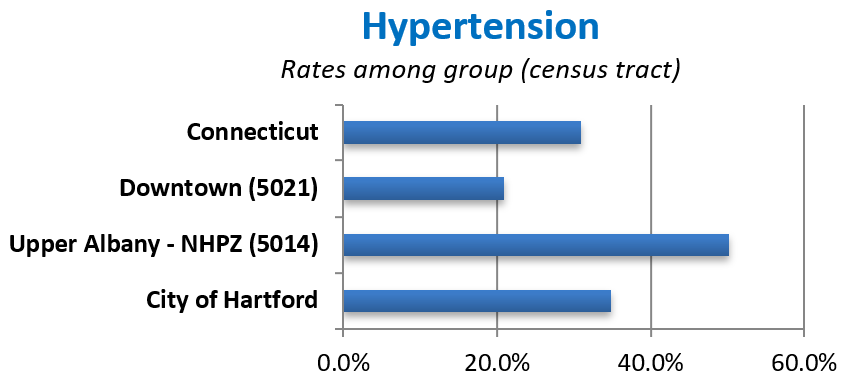
1 out of 2 black women in the NHPZ suffer from hypertension (high blood pressure), a rate nearly 50% higher than experienced by caucasian women statewide.
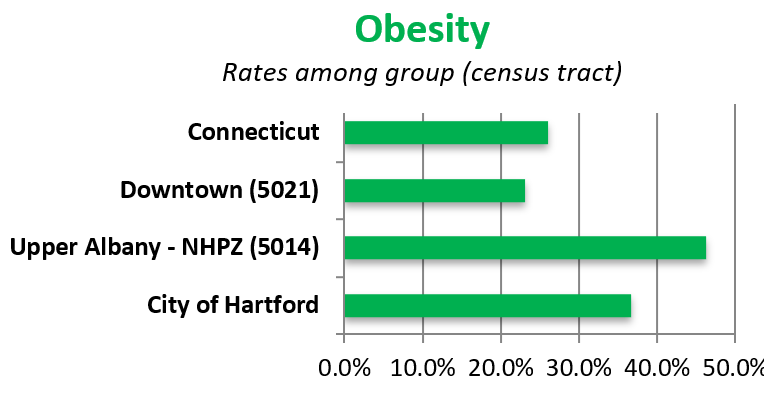
A Hartford resident living three blocks north of Dunkin Donuts stadium is 2x as likely to suffer from obesity as a resident living three blocks south of the stadium. Obesity significantly increases the likelihood of diabetes, high blood pressure, heart disease, and stroke.


